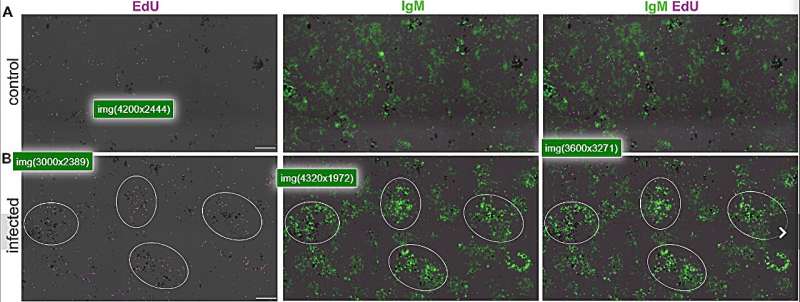This article has been reviewed according to Science X's editorial process and policies. Editors have highlighted the following attributes while ensuring the content's credibility:
fact-checked
peer-reviewed publication
trusted source
proofread
Scientists navigate uncharted waters in fish immunology research

Upon infection or immunization, all jawed vertebrate species generate proteins called antibodies that bind and neutralize pathogens. Strong and long-lasting antibody responses in warm-blooded species such as mammals are produced in secondary lymphoid microstructures (SLMs) among which germinal centers (GCs) are the centerpiece.
Despite the apparent absence of GCs or similar SLMs in cold-blooded vertebrates (e.g., fish), these species can mount significant antibody responses that can persist for several months. Thus, for decades, the outstanding question has remained as to how and where antibody responses are generated in species that lack GCs or analogous SLM structures.
A new study featured on the cover of the journal Science Immunology, reconsiders the understanding of immune responses in cold-blooded species. Investigators at the University of Pennsylvania's School of Veterinary Medicine (Penn Vet) have discovered, contrary to earlier belief, that induction of antibody responses in bony fish occurs in primordially organized SLMs that play roles similar to those of GCs from warm-blooded animals.
More specifically, the study identifies the formation in the spleen of large aggregates of highly proliferating B cells (the cells producing antibodies) and T cells (the cells helping B cells to produce antibodies) upon infection or immunization of fish. The newly induced B and T cell zones are formed nearby melanomacrophage centers (MMCs), which are tissue areas containing groups of dark-colored melanomacrophages where antigen is retained upon infection.
These newly discovered MMC-associated lymphoid aggregates (M-LAs), contain numerous antigen-specific B cells, thus highlighting their key role in the immune response. Moreover, similar to what ensues in GCs, B cell clonal expansion and somatic hypermutation processes occur within M-LAs.
"Our findings challenge the former dogma that fish do not contain specific lymphoid microenvironments where immune responses are generated while revealing a previously unknown type of SLM in jawed vertebrates" said J. Oriol Sunyer, corresponding author of the study, and professor of Immunology at Penn Vet. "This discovery has far-reaching implications for our understanding of the immune system's evolution and its potential applications in various fields, from fish vaccinology to human medicine."
The research presents a new perspective on how immune responses can be induced in vertebrates, thus offering new opportunities to understand primordially conserved principles through which M-LAs and GCs function.
"For instance, fish M-LAs are highly polyclonal structures, thus resembling newly identified mammalian GCs that operate in polyclonal settings," said Sunyer. "Therefore, the study of fish M-LAs is likely to shed light on the mechanisms by which both polyclonal GCs and M-LAs are formed."
From an applied perspective, these findings are critical for the generation of more effective knowledge-based vaccines for fish. Disease and health management problems are one of the major hurdles for the developing aquaculture industry in the U.S. and worldwide.
While vaccines delivered to fish have contributed enormously to the near eradication of several fish diseases, many vaccines for a number of old and emerging fish pathogens are inefficient due to our lack of knowledge on how immune responses are generated in these species.
"Now that we know where and how antibody responses are induced in fish, the study of M-LAs will identify correlates of immune activation and protection that will pave the road for the screening and development of more efficacious and safer vaccines and adjuvants for the aquaculture industry," added Sunyer.
More information: Yasuhiro Shibasaki et al, Cold-blooded vertebrates evolved organized germinal center like structures, Science Immunology (2023). DOI: 10.1126/sciimmunol.adf1627
Journal information: Science Immunology
Provided by University of Pennsylvania





















